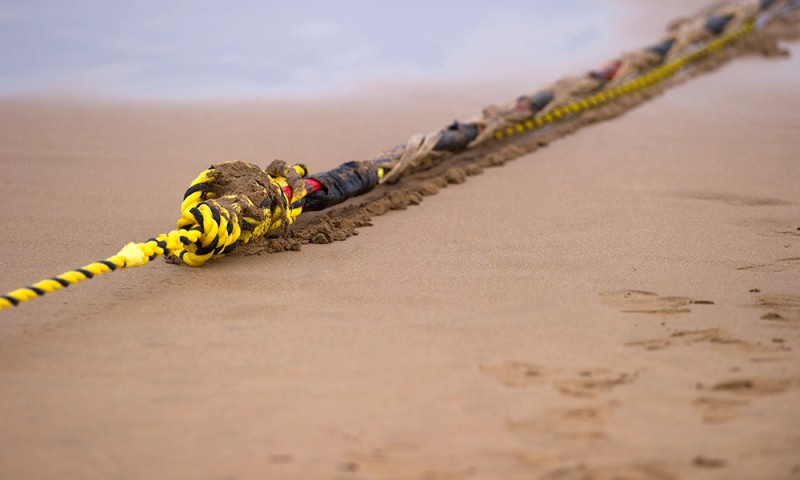
专家在上周日表示,红海海域的海底电缆遭切断,导致亚洲和中东部分地区的互联网服务受阻,但目前尚不清楚事故的具体原因。
外界担心,这些电缆可能成为也门胡塞武装在红海区域的袭击目标。该组织称其在该地区的行动旨在向以色列施压,要求其结束在加沙地带针对哈马斯的军事行动。但胡塞武装此前否认曾袭击过这些海底电缆。
海底电缆与卫星连接、陆地光缆共同构成互联网骨干网络。通常情况下,互联网服务提供商会设置多个接入点,如果其中一个失效,流量可以从其他线路重新路由,但可能导致网速变慢。
沙特阿拉伯附近多条电缆断裂
微软通过其状态更新网站发布公告称,中东地区“可能因红海海底电缆断裂而出现网络延迟加剧的情况”。这家总部位于美国华盛顿州雷德蒙德的公司未立即透露更多细节,但表示未经过中东地区的互联网流量“不受影响”。
互联网监测机构NetBlocks表示,“红海发生的一系列海底电缆断裂事件已导致多国网络连接质量下降”,其中包括印度和巴基斯坦。该机构将问题归咎于“沙特阿拉伯吉达附近SMW4和IMEWE电缆系统故障”。
“东南亚—中东—西欧4号”电缆由印度巨头塔塔通信公司(Tata Communications)运营。“印度—中东—西欧”电缆则由阿尔卡特海底网络公司(Alcatel Submarine Networks)牵头的另一财团运营。两家公司均未回应置评请求。
巴基斯坦电信业巨头巴基斯坦电信有限公司(Pakistan Telecommunications Co. Ltd.)在上周六发布声明,确认发生了电缆中断事件。
沙特阿拉伯方面未承认服务中断事件,当地政府也未回应置评请求。
科威特当局表示,途经红海的FALCON GCX海底电缆遭切断,导致这个石油资源丰富的小国网络中断。GCX公司未回应置评请求。
在阿联酋(迪拜和阿布扎比所在地),使用国有运营商Du和Etisalat网络的用户抱怨网速变慢。政府方面未承认服务中断事件。
海底电缆可能因意外事故和袭击而遭切断
海底电缆可能因船只抛锚而被意外切断,也可能成为袭击目标。修复工作可能耗时数周,因为维修船只和船员必须先准确定位受损电缆的位置。
此次电缆断裂事件发生之际,也门胡塞武装仍在持续对以色列发动一系列袭击,以抗议以色列在加沙地带针对哈马斯展开的军事行动。以色列则发动空袭作为反击,其中一次空袭击毙了该反政府武装的高级领导人。
2024年初,获得国际承认的也门流亡政府指控胡塞武装计划袭击红海海底电缆。当时,数条电缆被切断,可能是因一艘遭胡塞武装袭击的船只拖锚所致,但胡塞武装否认对此事负责。上周日,胡塞武装的“马西拉”卫星新闻频道援引NetBlocks的消息,承认了此次电缆断裂事件。
驻扎在也门南部的也门国际承认政府(与胡塞武装对立)的信息部长穆阿迈尔·艾里亚尼发表声明称,此次电缆断裂事件“与胡塞民兵实施的一系列直接攻击存在关联”。
艾里亚尼表示:“今天在红海发生的事件应当为国际社会敲响警钟,各国必须坚定立场,遏制不断升级的威胁,保护作为现代世界生命线的数字基础设施。”
自2023年11月至2024年12月,因加沙地带的以色列-哈马斯冲突,胡塞武装使用导弹和无人机袭击了逾百艘船只,迄今已击沉4艘船只,造成至少8名船员死亡。
伊朗支持的胡塞武装曾在战争短暂停火期间停止了袭击。随后,该组织成为美国总统唐纳德·特朗普下令实施的数周高强度空袭的目标,之后特朗普宣布与该组织达成停火协议。胡塞武装在7月击沉两艘船只,造成至少4人死亡,另有数人据信被该组织扣押。
胡塞武装发动新一轮袭击发生之际,以色列—哈马斯可能达成新一轮停火协议的前景尚不明朗。与此同时,以色列对伊朗发动了为期12天的战争,期间美军轰炸了伊朗三处核设施,这使得美伊两国就德黑兰受创核计划的谈判前景也存在变数。(*)
译者:刘进龙
审校:汪皓
专家在上周日表示,红海海域的海底电缆遭切断,导致亚洲和中东部分地区的互联网服务受阻,但目前尚不清楚事故的具体原因。
外界担心,这些电缆可能成为也门胡塞武装在红海区域的袭击目标。该组织称其在该地区的行动旨在向以色列施压,要求其结束在加沙地带针对哈马斯的军事行动。但胡塞武装此前否认曾袭击过这些海底电缆。
海底电缆与卫星连接、陆地光缆共同构成互联网骨干网络。通常情况下,互联网服务提供商会设置多个接入点,如果其中一个失效,流量可以从其他线路重新路由,但可能导致网速变慢。
沙特阿拉伯附近多条电缆断裂
微软通过其状态更新网站发布公告称,中东地区“可能因红海海底电缆断裂而出现网络延迟加剧的情况”。这家总部位于美国华盛顿州雷德蒙德的公司未立即透露更多细节,但表示未经过中东地区的互联网流量“不受影响”。
互联网监测机构NetBlocks表示,“红海发生的一系列海底电缆断裂事件已导致多国网络连接质量下降”,其中包括印度和巴基斯坦。该机构将问题归咎于“沙特阿拉伯吉达附近SMW4和IMEWE电缆系统故障”。
“东南亚—中东—西欧4号”电缆由印度巨头塔塔通信公司(Tata Communications)运营。“印度—中东—西欧”电缆则由阿尔卡特海底网络公司(Alcatel Submarine Networks)牵头的另一财团运营。两家公司均未回应置评请求。
巴基斯坦电信业巨头巴基斯坦电信有限公司(Pakistan Telecommunications Co. Ltd.)在上周六发布声明,确认发生了电缆中断事件。
沙特阿拉伯方面未承认服务中断事件,当地政府也未回应置评请求。
科威特当局表示,途经红海的FALCON GCX海底电缆遭切断,导致这个石油资源丰富的小国网络中断。GCX公司未回应置评请求。
在阿联酋(迪拜和阿布扎比所在地),使用国有运营商Du和Etisalat网络的用户抱怨网速变慢。政府方面未承认服务中断事件。
海底电缆可能因意外事故和袭击而遭切断
海底电缆可能因船只抛锚而被意外切断,也可能成为袭击目标。修复工作可能耗时数周,因为维修船只和船员必须先准确定位受损电缆的位置。
此次电缆断裂事件发生之际,也门胡塞武装仍在持续对以色列发动一系列袭击,以抗议以色列在加沙地带针对哈马斯展开的军事行动。以色列则发动空袭作为反击,其中一次空袭击毙了该反政府武装的高级领导人。
2024年初,获得国际承认的也门流亡政府指控胡塞武装计划袭击红海海底电缆。当时,数条电缆被切断,可能是因一艘遭胡塞武装袭击的船只拖锚所致,但胡塞武装否认对此事负责。上周日,胡塞武装的“马西拉”卫星新闻频道援引NetBlocks的消息,承认了此次电缆断裂事件。
驻扎在也门南部的也门国际承认政府(与胡塞武装对立)的信息部长穆阿迈尔·艾里亚尼发表声明称,此次电缆断裂事件“与胡塞民兵实施的一系列直接攻击存在关联”。
艾里亚尼表示:“今天在红海发生的事件应当为国际社会敲响警钟,各国必须坚定立场,遏制不断升级的威胁,保护作为现代世界生命线的数字基础设施。”
自2023年11月至2024年12月,因加沙地带的以色列-哈马斯冲突,胡塞武装使用导弹和无人机袭击了逾百艘船只,迄今已击沉4艘船只,造成至少8名船员死亡。
伊朗支持的胡塞武装曾在战争短暂停火期间停止了袭击。随后,该组织成为美国总统唐纳德·特朗普下令实施的数周高强度空袭的目标,之后特朗普宣布与该组织达成停火协议。胡塞武装在7月击沉两艘船只,造成至少4人死亡,另有数人据信被该组织扣押。
胡塞武装发动新一轮袭击发生之际,以色列—哈马斯可能达成新一轮停火协议的前景尚不明朗。与此同时,以色列对伊朗发动了为期12天的战争,期间美军轰炸了伊朗三处核设施,这使得美伊两国就德黑兰受创核计划的谈判前景也存在变数。(*)
译者:刘进龙
审校:汪皓
Undersea cable cuts in the Red Sea disrupted internet access in parts of Asia and the Middle East, experts said Sunday, though it wasn’t immediately clear what caused the incident.
There has been concern about the cables being targeted in a Red Sea campaign by Yemen’s Houthi rebels, which the rebels describe as an effort to pressure Israel to end its war on Hamas in the Gaza Strip. But the Houthis have denied attacking the lines in the past.
Undersea cables are one of the backbones of the internet, along with satellite connections and land-based cables. Typically, internet service providers have multiple access points and reroute traffic if one fails, though it can slow down access for users.
Multiple cables cut off Saudi Arabia
Microsoft announced via a status website that the Mideast “may experience increased latency due to undersea fiber cuts in the Red Sea.” The Redmond, Washington-based firm did not immediately elaborate, though it said that internet traffic not moving through the Middle East “is not impacted.”
NetBlocks, which monitors internet access, said “a series of subsea cable outages in the Red Sea has degraded internet connectivity in multiple countries,” which it said included India and Pakistan. It blamed “failures affecting the SMW4 and IMEWE cable systems near Jeddah, Saudi Arabia.”
The South East Asia–Middle East–Western Europe 4 cable is run by Tata Communications, part of the Indian conglomerate. The India-Middle East-Western Europe cable is run by another consortium overseen by Alcatel Submarine Networks. Neither firm responded to requests for comment.
Pakistan Telecommunications Co. Ltd., a telecommunication giant in that country, noted that the cuts had taken place in a statement on Saturday.
Saudi Arabia did not acknowledge the disruption and authorities there did not respond to a request for comment.
In Kuwait, authorities also said the FALCON GCX cable running through the Red Sea had been cut, causing disruptions in the small, oil-rich nation. GCX did not respond to a request for comment.
In the United Arab Emirates, home to Dubai and Abu Dhabi, internet users on the country’s state-owned Du and Etisalat networks complained of slower internet speeds. The government did not acknowledge the disruption.
Undersea lines can be cut in accidents and attacks
Subsea cables can be cut by anchors dropped from ships, but can also be targeted in attacks. It can take weeks for repairs to be made as a ship and crew must locate themselves over the damaged cable.
The cuts to the lines come as Yemen’s Houthi rebels remain locked in a series of attacks targeting Israel over the Israel-Hamas war in the Gaza Strip. Israel has responded with airstrikes, including one that killed top leaders within the rebel movement.
In early 2024, Yemen’s internationally recognized government in exile alleged that the Houthis planned to attack undersea cables in the Red Sea. Several were cut, possibly by a ship attacked by the Houthis dragging its anchor, but the rebels denied being responsible. On Sunday morning, the Houthis’ al-Masirah satellite news channel acknowledged that the cuts had taken place, citing NetBlocks.
Moammar al-Eryani, the information minister with Yemen’s internationally recognized government that opposes the Houthis and is based in southern Yemen, issued a statement saying the cable cuts “cannot be isolated from the series of direct attacks carried out by the Houthi militia.”
“What is happening today in the Red Sea should serve as a wake-up call for the international community, which must take a firm stance to stop these escalating threats and protect the digital infrastructure that serves as the lifeline of the modern world,” al-Eryani said.
From November 2023 to December 2024, the Houthis targeted more than 100 ships with missiles and drones over the Israel-Hamas war in the Gaza Strip. In their campaign so far, the Houthis have sunk four vessels and killed at least eight mariners.
The Iranian-backed Houthis stopped their attacks during a brief ceasefire in the war. They later became the target of an intense weekslong campaign of airstrikes ordered by U.S. President Donald Trump before he declared a ceasefire had been reached with the rebels. The Houthis sank two vessels in July, killing at least four on board, with others believed to be held by the rebels.
The Houthis’ new attacks come as a new possible ceasefire in the Israel-Hamas war remains in the balance. Meanwhile, the future of talks between the U.S. and Iran over Tehran’s battered nuclear program is in question after Israel launched a 12-day war against the Islamic Republic in which the Americans bombed three Iranian atomic sites.

